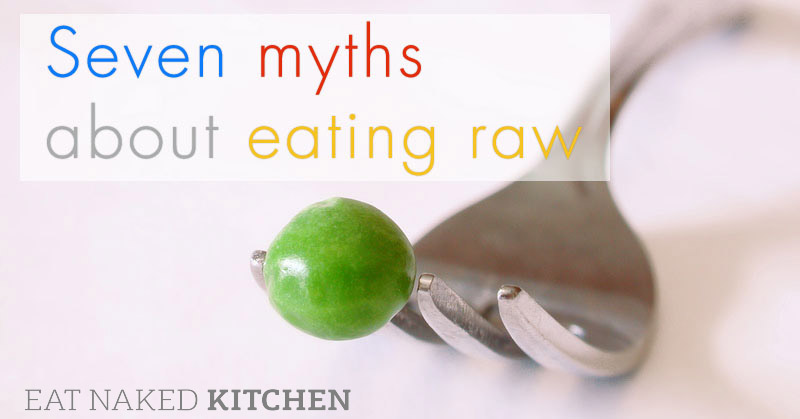As we approach the end of our 30 Day raw adventure, I look back and see how many things I used to believe about a raw diet that have changed for me with this experience. Here are my top seven:
1) Eating raw requires a ton of food prep
Busting this myth was perhaps the biggest surprise for me. We have a sense that eating raw requires hour upon hour of complicated food preparation. I believe this may be so if you eat a raw vegan diet, which requires a ton of soaking and sprouting of grains and legumes to make these foods digestible without cooking. But on a raw primal diet, the food preparation is actually quite minimal. This was a pleasant surprise and, in our very busy life, a necessary one.
2) If it says raw on the package, it means it’s raw
Food labeling has always been a beef of mine because most of the time it’s about marketing, not health. This certainly extended to the “raw” label, in large part because there’s no formal definition or consensus around what raw actually means. Different experts have different temperature requirements, and for certain packaged foods (a minefield to begin with, but I had higher hopes and expectations of the companies in this category) it seems the percentage of raw ingredients is flexible.
Like anything packaged, you ultimately have to read the label and become a nutrition super-sleuth. Ingredients to watch for in “raw” products: refined oils (as you can assume any vegetable oil is unless specified otherwise), maple syrup, any soy product, and agave, among others. As always, your best option is to make it yourself at home, so you have 100% control. Remember: you need to consider all stages in the processing not only of the final product, but of every ingredient.
3) If it’s cold, it’s raw
This might seem like I’m stating the obvious, but when you’re first getting into raw cuisine it takes some significant mental adjustment to distinguish between something that is simply “cold” versus something that is “raw” (as in: has never been heated above a certain temperature).
A couple of examples of this: Nori – the sushi-wrapping seaweed sheets – “feels” raw, but in fact is made from roasted seaweed. I was surprised at how many “raw” recipes included this ingredient. And indeed, it wasn’t until Chef James pointed out that nori is made from roasted seaweed that I even considered it a problem. Raw nori does exist, but it’s hard to find.
Another example of this is an ingredient such as soy sauce. We only consume either gluten-free tamari or shoyu soy sauce (both traditionally fermented rather than the intensive and nutrient-destroying hydrolyzation process that most soy sauces undergo), but neither of these are officially “raw”. There is one type of shoyu soy sauce – nama shoyu – that is considered raw, but it contains wheat, which we generally avoid. So in our case, we opted for the gluten-free tamari even though it isn’t considered raw.
4) Eating raw meat is dangerous
It’s actually surprising to me how many people firmly hold to this belief and then happily go out for sushi. Raw meat and other raw animal foods, such as raw milk and raw eggs, have been and are still consumed in traditional societies around the globe for thousands of years. I *knew* this in my head going in, but I found myself still nervous eating those first few bites of Steak Tartare or Beef Carpaccio.
Did I get sick on this diet? Yes, once: when I cheated and ate some cooked spinach!
Now, I’d never recommend you go out to your local supermarket and tear into some raw hamburger meat. You need to consider food quality and food safety when eating any food raw, which we followed to the “T”.
5) You’ll be constantly hungry when eating raw
I was actually quite concerned about this one going in. Would I be hungry all the time and find myself trolling the kitchen cupboards, trying to fill myself? Both Chef James and I experienced quite the opposite. We found we needed to eat far less than usual to be satiated, and as a result generally felt lighter and happier. My theory: the nutrients were so readily available to our bodies and there was so little wasted that we needed less to feel full.
6) Eating raw will decrease your body temperature
This myth went hand-in-hand with my concern about not being satiated. It’s October, and yes, we live in Los Angeles, but still the days are getting shorter, the nights are getting cooler. Wouldn’t I be cold all the time? I actually run on the colder side already, so this was a big concern.
Perhaps due to the raw animal foods we were eating, this never was a problem. In fact, I found that I was generally warmer than I normally am. That’s not to say I didn’t crave a nice bowl of soup or stew on the cooler evenings, but it wasn’t that I was actually cold – it was more of an emotional association.
7) Raw = vegan
This wasn’t a myth I believed when I started this challenge, but it certainly was the most common one we encountered. If you’ve been reading any of my posts over the course of this month, you’ll know that raw doesn’t have to mean vegan, or exclusively primal either. It can be many shades of gray in between.




It’s the raw vegan diet that kept me on the very cold side, not in summer, but as soon as it grew cool enough for us to use heat. I found myself turning it up to 76 – and still shivering.